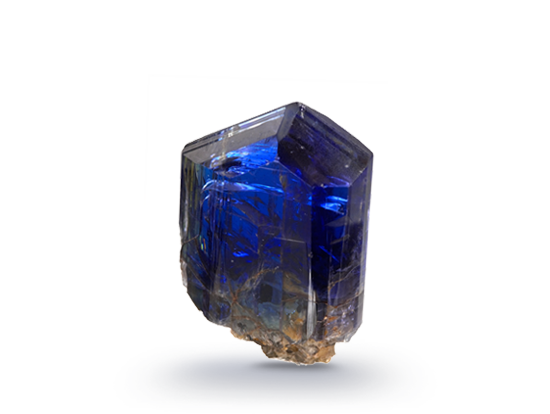OVERVIEW
Found in just one place on earth, tanzanite is a relatively recent discovery. Tiffany & Co named this blue-violet variety of zoisite in honor of Tanzania, where it was first unearthed in 1967. Because the crystals show different colors depending on the viewing direction, cutters can fashion gems with a range of color from violetish blue to bluish violet depending on how much weight they want to retain from the rough.
Tanzanite is the violet blue to blue violet variety of the mineral zoisite. It is mined commercially only in one area of the world: the Merelani Hills of Tanzania, which is where it gets its name.
Tanzanite’s appearance is influenced greatly by its pleochroism, which is the ability of a gemstone to show different colors when viewed in different crystal directions. Tanzanite’s pleochroism was documented in scientific papers not long after its discovery. In 1969, American Mineralogist described the gem’s pleochroic colors as `red-violet, deep blue, and yellow green.’ Today, most gems are heat treated, which removes or reduces the yellow green or brownish pleochroic color, maximizing the blue and violet.
Top-quality tanzanite can be violetish blue –similar to a fine sapphire color –or a unique, predominately violet hue all its own. Some stones might also appear more purplish depending on how the cutter chooses to orient the fashioned gem. Both the violet and blue pleochroic colors are readily visible in a fashioned stone when it is gently rocked and tilted. This means that every tanzanite is a blend of these pleochroic colors. The exact face-up color depends on the inherent color of the original rough, its size, the pleochroic colors the cutter favors when they orient the fashioned stone, and the light the finished gem is viewed under. Cool lighting –like daylight equivalent fluorescent –will emphasize tanzanite’s blue, while warm lighting –like incandescent –will make it appear more violet-to-purple.
Just like other colored gemstones, vivid strongly-colored tanzanites are highly sought after. Lighter toned pastel hues are more plentiful and affordable than vivid colors and have a subtle appeal of their own.
- Mineral: Zoisite
- Chemistry: Ca2Al3(SiO4)3(OH)
- Color: Violet blue to bluish violet to violet purple
- Refractive Index: 1.691 to 1.700
- Birefringence: 0.008 to 0.013
- Specific Gravity: 3.35
- Mohs Hardness: 6 to 7
WHERE IS IT FOUND ?
The Merelani Hills of northern Tanzania is the only place on earth where tanzanite is mined comercially. Grass-covered hillsides, scrub brush, rocky soil and an occasional tree form the local landscape. In the major mechanized operations there, thousands of workers recover tanzanite from mines dug over a 100 meters (more than 300 feet) deep into the earth. North of the mines tower the snow-covered slopes of Mount Kilimanjaro.
CARE & CLEANING
This December birthstone (6 to 7 on the Mohs scale of harness) is resistant to the effects of normal heat, light and common chemicals. Still, the December birthstone may crack if exposed to very high temperatures or sudden temperature changes, and it abrades easily. It can be attacked by hydrochloric and hydrofluoric acids.
Most tanzanite begins as brownish zoisite that is heat treated to produce the blue to violet hues that characterize this December birthstones. The resulting color is permanent, and there are no additional durability concerns.
Your tanzanite birthstone is best set in earrings or pendants. While not recommended for daily wear in a ring, with a protective mounting and some care this December birthstone can be an attractive special-occasion jewel.
BIRTHSTONE
Tanzanite is a birthstone for December, along with zircon, turquoise, and blue topaz. Tanzanite is also the gem for a 24th anniversary.
HISTORY
Tanzanite is relatively new to the colored stone galaxy. As the most common story of the tanzanite mining boom goes, in 1967 a Masai tribesman stumbled upon a cluster of highly transparent, intense violet-to-blue crystals weathering out of the earth in Merelani, an area of northern Tanzania. He alerted a local fortune hunter named Manuel d’Souza, who quickly registered four mining claims.
D’Souza hoped that he’d been shown a new sapphire deposit. Instead, the deposit contained one of the newest of the world’s gems.
Within a short time, 90 more claims appeared in the same 20-square-mile area. No one was quite sure what the beautiful crystals were, but everyone wanted to lay claim to the profits they were certain to produce. The new gem would eventually be known as tanzanite, and it would, at times, rival the Big 3 in popularity.
Tiffany & Company recognized its potential as an international seller and made a deal to become its main distributor. Tiffany named the gem after the country it came from, and promoted it with a big publicity campaign in 1968. Almost overnight, tanzanite was popular with leading jewelry designers and other gem professionals, as well as with customers who had an eye for beautiful and unusual gems.
The instant popularity of this transparent blue-to-violet gem was tied to its vivid color, high clarity, and potential for large cut stones.
Source of Content : www.gia.edu


